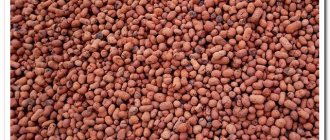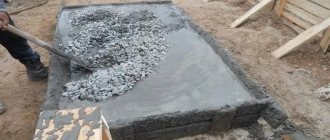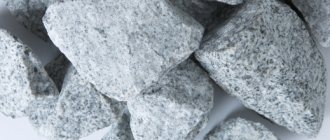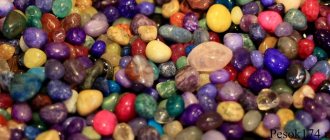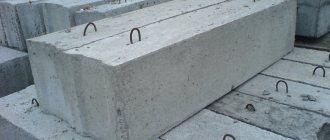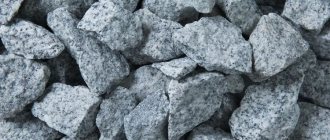Due to the fact that construction is gaining momentum every year, the demand for materials used for it is also increasing. Some of the most popular stones used in the construction of various structures are gravel and crushed stone .
There are certain differences between the two that people often don't realize once they start getting into the construction process. It should be understood that this information is extremely important, since, based on it, you should make a choice in favor of one material or another.
Correct use of stones is the key to successful completion of the work.
Features of gravel, description of what gravel material looks like
In order to clearly understand all the characteristics of gravel, you should first analyze the methods of its origin. The material is rock deposits that are formed by the sedimentary method of occurrence. Because of this, the structure of the gravel is quite loose.
Gravel contains certain harder elements in the form of minerals that came from the destruction of fairly large blocks.
Experts distinguish the following types of gravel depending on the size of its fractions:
- fine material. Its particle size is only 1 to 2.5 millimeters. In essence, it is a kind of sand;
- medium material. Its stones have dimensions of no more than 5 millimeters in each projection;
- large material . It is the largest type of gravel. Its fractions reach 10 millimeters in size.
The origin of gravel can also be quite different. Experts distinguish the following types of this material:
- rock material;
Mountain
- river material;
River
- marine material;
Nautical
- glacial material;
Glacial
- lake material.
Ozerny
The above varieties of gravel have different characteristics. For example, rock materials have the highest adhesive properties. The lowest indicators of this property are found in river and sea stones.
This is due to the fact that their surface is quite smooth due to the constant movement of water and polishing that occurs in this way.
Most often, specialists use mountain gravel in construction, since its adhesive properties are the highest.
The scope of its application is quite diverse. With its help, you can lay road cushions and fill up certain areas. Gravel is often used as a filler in the preparation of various mixtures of concrete and mortars.
This material is also used for pouring foundations and many other elements of structures. Gravel can be completely different in color. This stone is found in blue and pink, as well as yellow and brown.
Thus, we can conclude about its high aesthetic properties. Because of this, this material is often used for decorative purposes. Recently, in public gardens and parks, no work can be done without the use of gravel.
First of all, this is influenced by its color scheme, which allows you to create almost real pictures on the ground. What is the difference between gravel and crushed stone must be understood, since the wrong choice of material can lead to certain difficulties in construction, loss of money and time for the commissioning of the project.
Grain composition
If crushed stone is made from the same rock and has grains of approximately the same size, then gravel is quite the opposite. It may contain particles of different rocks, sizes, degrees of roundness and weathering.
This can be clearly seen in the image below.
Crushed marble (right) is uniform in color and grains are similar in size. Gravel consists of a mixture of stones belonging to different rocks. Each grain has its own shape, its own size, its own shade.
Moreover, even different types of gravel can be very different from each other. Let's take mountain and river gravel as an example:
The top row contains grains of the mountain variety. They are less rounded and less durable. The bottom row is river gravel. The difference is visible quite clearly.
Characteristics of crushed stone, what is the difference with gravel
It is quite easy to distinguish crushed stone from gravel due to the fact that these building materials have quite different appearances. The first is characterized by a completely different structure. Crushed stones have roughness, abrasions and sharp corners that are visible even to the naked eye.
The size of this material is often significantly larger than the size of gravel. This information is also indicated in the relevant GOST.
Extraction of crushed stone occurs by crushing certain rocks. First of all, they are boulders, granite and limestone.
A distinctive feature of crushed stone is that, with the help of its rough structure, it can adhere quite well to many other materials. This significantly expands its practical possibilities for use in the construction industry.
The purpose of crushed stone is based directly on the size of its stones . This correspondence must be taken into account when selecting material for specific tasks.
Crushed stone comes in the following sizes:
- fraction up to 5 millimeters. Such material is called screening by a specialist . It is formed as waste from the production of larger stones. Crushed stone of this size is used to form roads and platforms;
Fraction 0-5 mm
- they are often sprinkled on the roadway during icy conditions, as this significantly helps improve the adhesion of coated car wheels;
- fraction from 5 to 10 millimeters. This material is also considered to be quite small, so it is used mainly for the preparation of cement mortars and concrete. It is also used to form concrete and reinforced concrete slabs;
Fraction 5-10mm
- fraction from 10 to 20 millimeters. This material has medium sized components. It is most often used in the construction of bridges , as well as in the construction of foundations for structures and road surfaces;
Fraction 10-20
- fraction from 20 to 40 millimeters. Builders most often use this material to create complex and rather heavy structures;
Fraction 20-40
- fraction from 40 to 70 millimeters. Such large stones are used to build multi-story structures and road surfaces. Stones of similar sizes are able to withstand quite significant loads without being subject to deformation;
Fraction 40-70
- fraction from 70 to 120 millimeters. Such material can only serve as a decorative element . It should not be used as a filler.
Fraction 70-120
If we talk about the performance properties of crushed stone, then it is worth mentioning its strength and resistance to low temperatures. Depending on the last factor, the material is even divided into different classes of frost resistance. You should pay attention to this when choosing a stone for outdoor use.
Gravel and crushed stone also have differences in price. The cost of these materials depends on many factors that need to be taken into account when purchasing them.
For more information about the characteristics of crushed stone, watch the video:
Grain structure
Since the gravel was on the surface of the earth for a long time and exposed to the atmosphere, it preserved the characteristics of the original rock much less well. The crushed stone is crushed in a quarry and immediately sent for sale. Therefore, its structure is much more pronounced.
Let's look at the photo again:
Comparative analysis of crushed stone and gravel - how they differ
Despite almost the same origin, crushed stone and gravel are used for completely different construction purposes. Among the main differences, it is also worth highlighting adhesion - the ability to adhere to other materials.
In this regard, gravel is largely inferior to crushed stone. Therefore, the latter has a wider range of applications. This is affected by its irregular shape, the presence of corners, rough surface, etc.
In addition, it is definitely worth noting the physical superiority of crushed stone over gravel.
The first material is significantly stronger and resistant to various mechanical influences. The angles and presence of planes in the crushed stone ensure that the stone compacts well. This means that there will be fewer voids in a layer of such material than in a round one, like gravel.
In turn, this property affects the stability of structures and elements. Different types of gravel have approximately the same appearance. Because of this, it is possible to make a slight mistake when choosing this material. This will not happen with crushed stone, since it has more pronounced features.
It is worth noting the difference between the two types of materials in aesthetic terms. Here gravel beats crushed stone by several points. This is due to the presence of a smooth and beautiful surface, as well as a variety of colors.
In comparison, gravel can be called an ideal stone to be used for decorative purposes. First of all, this concerns landscape gardening art.
Gravel
In addition, it is used to decorate the facades of houses and some other elements of buildings. This way they become more attractive and interesting. Crushed stone, due to the lack of such aesthetic properties, does not allow making any decorative details.
Currently, quarry sand is rightfully the most common material used in construction and repair. Here are all its characteristics.
High-quality cement is an excellent binder, without which it is impossible to make any repairs. Here is a breakdown of cement grades.
Today it is impossible to make high-quality finishing of walls and ceilings without first treating them with plaster. By following the link you will learn how to level walls with plaster.
Also, the difference between gravel and crushed stone is that the first is an already formed mountain nature with its own unique properties and parameters, and the second is a material that requires crushing. That is, in essence, stones have different methods of extraction and creation mechanisms.
The gravel that nature created by influencing it with some of its own forces (friction, gravity, etc.) has a more complete and beautiful form.
The same mineral that was produced through human intervention has a less aesthetic appearance. Thus, we can conclude that the properties and characteristics of crushed stone, due to its crushing and low decorative properties, made it possible to use it in a wider range of different construction applications.
At the same time, gravel, having a variety of colors and quite beautiful appearance, gained its popularity mainly for decorative purposes.
The photo allows you to understand how gravel differs from crushed stone. The picture shows different fractions of these materials, each having a unique shape and unique color.
Crushed stone and gravel
It is worth noting that there is such a stone as crushed gravel. It is made artificially. To do this, they break the monolithic rock with certain tools. Crushed stone and gravel have certain differences between themselves.
First of all, this concerns the production method. The second material is created by nature, and not through human intervention.
Factions
During the purchasing process, special attention should be paid to gravel fractions. They are determined both by the size of the granules and by density. Grains can have sizes from 5 to 70 mm.
Main gravel fractions (mm):
- 5(3)-10;
- 10-15;
- 10-20;
- 15-20;
- 20-40;
- 40-80(70);
- combination of fractions 5(3)-20.
Material in the form of other combinations of different fractions and larger grains can be produced by agreement between the manufacturer and the buyer.
Gravel 3-10 mm in size is used in the construction of playgrounds and sports grounds, private beaches, for filtering wells or springs, and in floristry. Gravel 10-20 mm in size is used to produce lightweight concrete. In 1 m3 of concrete there is approximately 1 ton of gravel in the form of filler.
Large fractions of the order of 20-40 mm are used for the construction of highways, bridges, airfield surfaces, etc. Gravel with a size of 40-70 mm and above is used primarily as a decorative material. It is used to decorate aquariums, swimming pools, animal cages, pave streets, and use it in the construction of dams.
Due to its versatility, combined with ease of use and low cost, gravel is widely used in the construction industry.
Differences and similarities of materials
By analyzing gravel and crushed stone, it is possible to draw some conclusions regarding the individual properties of these materials. They can be expressed this way:
- nature of education. Both materials are of inorganic origin from rocks. In this regard, there are no differences between them. They are completely identical in their original appearance;
- creation mechanism. Gravel is created by influencing the material by certain forces of nature, and crushed stone is formed by influencing blocks of rock by humans;
Gravel
- appearance. Gravel has a streamlined shape, many different colors and decorative features. Crushed stone is distinguished by sharp corners, the presence of planes and a limited number of shades;
Crushed stone
- operational properties. Gravel is not able to withstand heavy weight and significant loads, as well as the effects of severe and prolonged frosts. In this regard, this material is rather weak;
- crushed stone is able to withstand the effects of heavy loads and periods of changes in ambient temperature;
- they also differ in density characteristics; for crushed stone it is slightly higher than for gravel;
- scope of application. Gravel is primarily a decorative material, without which it is quite difficult to create a beautiful appearance for construction projects. Crushed stone refers to structural stones, since with its help certain elements of structures are created, which serve as their main function.
If you take into account all the above factors, you can really choose the material that is needed. According to this scheme, it is worth approaching the purchasing process by comparing certain properties and capabilities of stones.
The photographs allow you to see the differences between gravel and crushed stone. First of all, this concerns their decorativeness and appearance.
What's better?
This question is not entirely correct. In response to this, I would like to clarify: what is better for concrete or for drainage?
For example, the differences for filling a yard are insignificant. Both materials will do. If we are talking about concrete, it is better to use crushed stone. Since sharp edges will provide better adhesion, the structure will be more durable. Gravel, due to the influence of natural forces, can crumble. Plus, it contains various impurities that will negatively affect the quality of the mixture.
When choosing which is better, you also need to take into account the cost of these building materials. All other things being equal, crushed stone is usually 30-40 percent more expensive. Therefore, if there are no strict requirements, then you can save a lot on the difference in price.
Although there are no special differences between these materials (provided that we are talking about approximately the same fraction and composition). But it is not always possible to use gravel instead of crushed stone.
Characteristics of washed (alluvial) sand
The process of processing quarry sand to obtain seeded sand that complies with GOST standards requires special equipment and skills.
- The presence of harmful impurities in the bulk substance in excess of 0.3% is unacceptable;
- the predominant number of medium-sized fractions is 1.6-2.4 mm;
This process consists of sifting the mined material through sieves, the sections of which have different sizes. Thus, division into factions occurs. The structure of the sand obtained after such processing becomes homogeneous, which significantly improves the quality of the mixtures in which it will be used.
According to its characteristics, seeded sand is no worse than washed sand, but costs an order of magnitude lower. Seeded sand of classes I and II, with a fineness modulus from 0.2 to 3.5, is more expensive, which is due to the following performance characteristics:
- high bulk density of homogeneous material – 1800 kg/m3;
- environmental safety of sand;
- resistance to temperature changes;
- filtration coefficient – 11 m3/day;
When choosing seeded sand, you need to take into account the tasks facing the construction organization purchasing this material.
Crushed stone or asphalt chips
Before moving on to comparing materials, it is necessary to determine what asphalt chips are.
Asphalt crumb (or asphalt chips or asphalt granulate) is a secondary material obtained by cold milling old asphalt concrete or by crushing large fragments of removed asphalt pavement. The composition of the crumb includes particles of bitumen and small crushed stone measuring 3-5 mm. in diameter, may contain a small amount of sand, rubber inclusions, cement and other elements.
Advantages, features
The main advantages and positive features of asphalt crumbs include:
The disadvantages are a greater impact on the environment compared to crushed stone and the need for periodic renewal of the road surface (this disadvantage is not limited to asphalt chips).
Areas of application
Low cost and ease of operation ensure the demand for the material, so the crumb is used:
What's better
There is no clear answer to the question - what is better, crushed stone or asphalt chips? - No. Based on the information presented above about the list of works performed using crumbs, it is possible to conclude that the material is suitable for road and construction work . Asphalt chips can be used for landscape work, but the material is not very popular as a decorative element.
When implementing projects, crushed stone, gravel, chips, sand and screenings perform essentially similar functions. Therefore, when choosing, you should take into account the initial data. First, the budget. The price of crumbs is lower, but crushed stone has less harmful effects. Secondly, the initial data. For example, when building a road, it is necessary to take into account the condition and water content of the soil. The less durable the base, the more suitable crushed stone is. Conversely, dry conditions allow the use of crumb filling.
River pebbles for concrete. Decorative pebble paving
Landscape design often contains elements of pebble paving, which go well with many garden design styles. Alleys lined with pebbles turn out nice and look very nice. Natural stone, especially polished to a shine, is an ideal material for creating garden and park paths.
The technology of paving with pebbles, in itself, is not complicated, and anyone can do it. It is often used not only to create garden alleys and park paths, but also to decorate walls, borders and parapets, because the use of this material provides an effective and very attractive coating.
Paving material, as such, can be of marine origin, as well as lake or river, the variety of colors and sizes of which provides an incredibly large number of design options for suburban areas. However, one of the important issues on which the possibility of the existence of a path depends is the cost of pebbles. The price of the material largely depends on the color and origin of the stones. So, sea pebbles, of various types, will cost approximately 4,000 rubles per ton. The price of large sea or river pebbles can be about 250-300 rubles per 25 kilograms.
However, pebble paving is very popular. It is used not only for exterior, but also for interior decoration. For example, if you finish the bathroom floor in this way, your feet will receive a wonderful foot massage with a pleasant feeling of the seashore.
Pebble paving technology
It is advisable to start laying paths from pebbles by drawing out the diagram on paper, especially if you want to get a complex pattern. In this case, the colors must be indicated on the diagram. Then, you can begin to put the idea into practice.
The pebbles are laid on cement mortar, but here it is necessary to take into account the specifics of the work, which has its own subtleties.
First of all, you need to prepare the surface. To do this, you need to dig a pit no more than 35 centimeters deep and level its bottom. Fill the bottom with sand, in a layer of 10 centimeters, and compact it. Then, there will be a 20-centimeter layer of fine granite crushed stone, which should also be compacted. By the way, it is better to buy granite crushed stone at wholesale prices from specialized companies. Pour a mixture of sand and cement onto the crushed stone in a ratio of 3:1. Level the surface.
A path with a complex pattern must be laid with pebbles over the entire surface at the time of paving, according to the diagram, taking into account all the elements and the distances between them. It is also necessary to monitor the size of the stones, and not to lose attention to the rows and width of the seam formed. For this purpose, you can use pegs and string twine between them.
Having laid a path of pebbles, you need to water it with water using a hose with a special nozzle, making sure that a strong stream of water does not fall on the pebbles. Under no circumstances should you walk along the path straight away. The mixture will begin to gain strength when it settles after watering and is saturated with water. After some time, the procedure of mixing the cement mixture must be repeated and the gaps between the stones must be filled with it. By pebble paving, you can get a surface that looks great, provided that the stones do not protrude too much from the mortar, no more than a few millimeters.
Path made of concrete and pebbles
One of the options for decorative pebble paving is a path made of pebbles and concrete. This installation is quite simple and can be done with your own hands, but the result will be excellent.
To make such a path, you first need to make a regular concrete path. Everything is as it should be: foundation, formwork, concrete pouring. While the surface has not hardened, pebbles are poured in, which need to be leveled and compacted a little, while making sure that the stones are not completely immersed in the solution. Here, both the thickness of the concrete layer and the size of the stones play an important role.
Using this technology, you can make an original path using large boulders for the surface in combination with small pebbles. Everything is very simple. You need to lay large stones on the prepared base, laying out a pattern from them, and fill the gaps with small pebbles. If you can create a color contrast, the path will turn out to be simply wonderful and original.
Application environment for granite screenings
Considering the technical indicators and cost of this raw material, it is valued all over the world, and its scope has no boundaries. It is used by individuals, it is in demand in various industries, and it is used by large and small construction companies.
In winter, city utility companies use it to remove ice from roads and sidewalks. Due to the presence of stone dust particles in its composition, it lies tightly on the ice, does not get wet like ordinary sand and makes the surface rough. In addition, they rarely simply sprinkle sand; salt is added to it, which corrodes our shoes and car tires.
This material is also used in decorating parks, squares, and fountains. Quarries produce granite of different colors, after crushing it either gray or reddish granite screenings are obtained. Due to the variety of colors, it has a share of use in landscape work. These are paths, flower beds, flower beds, etc.
Granite screening for walkways is the ideal solution. Weeds in park recreation areas do not grow through it, and pedestrian paths look neat and well-groomed. The track from the screenings is rolled with a roller, after which it acquires a very dense consistency, similar to asphalt, but much cheaper. Often such paths are made two-color, colors are combined.
Hard coverings for playgrounds must meet certain requirements: your feet should not sink in it like in sand, it should be hard, and the covering should not float after rain. Such an ideal material is granite screening - it is dense, durable, stable, and is not liked by animals that like to defecate in the sand. It does not contain clay, which sticks to shoes and spreads everywhere.
Similar requirements for surfaces for playgrounds are tennis courts and outdoor volleyball courts. Water passes through it easily and there will never be puddles on it.
Such a coating will be reliable, durable, and will not have to be changed every season, which will ultimately save money.
Due to the high bulk density, after compaction or rolling, screenings are sometimes used instead of expensive asphalt. In addition, in the sun, such material does not emit a smell, unlike asphalt.
Screening is constantly used in the production of concrete and products made from it.
It is used in the production of paving slabs and curbs; the 2-5 mm fraction is in demand in the production of high-strength ready-mixed concrete. These are products for bridges, floors, and places with high loads. It is also used in the production of asphalt concrete and in the repair of roads for various purposes.
Due to its reasonable price, it is successfully used as a backfill in concrete mixtures instead of sand or as an additive. Special equipment is used to extract sand, therefore its cost is more expensive.
Permanent use in dry building mixtures for finishing wall coverings. The 5 mm grain fraction is used in mixtures for “bark beetle” coating, which can often be seen on the walls of houses or buildings.
Blocks made using this screening are also especially popular among the population. They are used to build houses and premises for various uses. Low price of the block, excellent thermal insulation, ease of operation, speed of installation - these are the main factors that attract developers. They are environmentally friendly, easy to transport and store. Walls made from such blocks can be built thinner, thereby adding interior space and reducing the load on the foundation.
Execution of work
We found out whether a pillow is needed for a strip foundation and what materials are best used for this.
Now all that remains is to figure out how to properly arrange such a foundation with your own hands. In order to level the bottom of the foundation trench or pit, a layer of sand or gravel ten centimeters high is poured. In places where it is planned to expand the walls, concreting is used. The same option with a concrete pad is used when it is planned to build a strip foundation with reinforced piles from FBS blocks.
The crushed stone backfill is easy to install; just remember that the height of the embankment should not exceed the base, and the width parameters will be twice as large as the same foundation size. As a rule, the crushed stone layer is thirty centimeters, one share of which is sand.
Having leveled the base, we begin to arrange the pillow. First, a layer of sand is poured, which is spilled with water and compacted. The same applies to the gravel layer.
The most reliable option is a concrete pad. The process of arranging it takes a lot of time, but it can be done on your own. Just remember that you will have to spend money on the necessary materials. The thickness of such a support should exceed the parameters of the foundation by thirty centimeters.
Sand backfill
This type of foundation is the easiest to implement and most economical option, and is chosen by developers who are trying not only to save money, but also to speed up the construction process.
And although at first glance such a base does not inspire confidence in its reliability, it copes quite well with the tasks assigned to it. Sand under the foundation saves it from being washed away and ensures acceptable load effects on its lower part. The bulk material is leveled and compacted with a vibrating plate, periodically sprinkled with water.
If the soil is weak-bearing, gravel is used in addition to sand
Preparatory measures of this kind practically eliminate the shrinkage of the foundation, and here it is very important to perform the compaction correctly
Construction of crushed stone cushion
Before pouring this material, a sand layer up to fifteen centimeters high is arranged, which is leveled and compacted. After this, crushed stone is poured, the size of the stones being 2 - 2.5 cm, and also compacted. The crushed stone layer should be twenty to twenty-five centimeters.
During work, it is necessary to ensure that the stones lie tightly next to each other, filling all the empty areas. To complete this process, you will have to use a vibrating plate, which is guaranteed to help create the desired density.
The construction of the foundation will begin with a crushed stone layer, so the height of the cushion should reach zero level. Such a substrate for a strip foundation allows you to construct objects from any materials.
Concrete pad
Now let's figure out how to mount a concrete mortar platform. This design has only one negative point - it is quite expensive compared to other options, and everything else in this project is a complete advantage.
To begin with, it should be noted that the base will be durable if you follow the technological process, which looks like this:
- the construction site is cleared of vegetation and other debris;
- the soil is leveled;
- a layer of crushed stone is poured, the height of which is ten centimeters;
- compaction is performed;
- a formwork structure is installed around the entire perimeter of the cushion;
- the entire site is reinforced with steel rods before pouring the mortar;
- a concrete mixture is poured, the grade of which is determined taking into account the mass of the future object;
- the solution is carefully compacted with deep vibrators;
- It will take at least four weeks for the structure to fully gain strength.
The basis for the construction of the facility is ideal, but requires significant financial expenses.
Cemented pebbles. Cemented rocks
Plump clastic rocks in natural conditions can not only be compacted, but also cemented due to natural cementing substances that precipitate from circulating underground solutions. Such substances in their composition can be clayey, carbonate, ferruginous, or siliceous. Siliceous cement is strong, clayey cement is weak.
Consolidated rocks include conglomerates, breccias, sandstones, siltstones and mudstones.
Conglomerate and breccia - consist of cemented pebbles and crushed stones, respectively. Their density is 1.5 ... 2.9 g/cm3, strength is from 50 to 1600 kg/cm2. Significant fluctuations in strength are associated with the composition of the fragments, the type of cementing substance, etc. They are used as a building, facing material, and in the production of cements.
Sandstones (sandstones) are formed by cementation of sands. Durable sandstones with siliceous cement. Various colors: gray, brown, white, etc. Density 1.8 ... 2.5 g/cm3, strength from 50 to 2000 kg/cm2. The construction properties of sandstones deteriorate if they contain admixtures of pyrite, limonite, and clay. Siliceous sandstones are used in the manufacture of refractories, as walling, acid-resistant material, etc.
Requirements for components
When purchasing PGS, you must ensure that the strength of the gravel that is part of the mixture meets the requirements of GOST 8267-93. Frost resistance and grain content must meet precisely this GOST to ensure good quality PGS.
The sand that is part of the mixture in its grain composition must fully comply with GOST 8736-93. Sand can be coarse, fine and medium, and also very fine
It is also important to make sure that the particles contained inside the ASG passing through the small sieve N014 do not exceed 20%, enriched with 10% composition throughout the mass
Clay and dust particles in the ASG should not exceed 5%, otherwise the quality of the mixture will greatly deteriorate. The proportions must be precise to obtain the best quality.
Before purchasing an ASG, make sure that it complies with GOSTIf all the indicators correspond to the above data, then we can say with confidence that the ASG is suitable for construction and you can safely use the composition for critical work.
Also, in order to purchase a good and high-quality composition of ASG or OPGS, you need to make sure that it does not contain clogging inclusions.
Summarize
So, which is better - crushed stone or gravel, and what are their differences?
Let us highlight the main characteristics of these materials:
- Crushed stone is formed as a result of mechanical crushing, or rather an explosion, and gravel is obtained as a result of the natural destruction of rocks.
- Crushed stone has a wider dimensional grid and is used for various construction works. Gravel is used more for decorative purposes, although sometimes it can be used in the construction of a foundation. This is due, first of all, to the shape of the material: gravel is smoother, while crushed stone is angular, resulting in better adhesion to concrete and other building materials.
- The main advantages of crushed stone are its excellent adhesion and good physical properties, and gravel has a decorative appearance.
Practical recommendations
We have specifically presented for you all possible calculation options for creating the ideal concrete mixture. Now you, as a concrete production specialist, can give advice to inexperienced craftsmen. But finally, we have a super life hack that will allow you to prepare concrete without complex formulas and tables.
Prepare a piece of paper with a pen, a jar (1 l), a bucket (10 l), cement, ASG, water. Let's get started:
- First, let's measure how much water fits into a 10-liter bottle of water. It’s logical that 10. Let’s write it down on paper.
- Now let's fill a full bucket of crushed stone and pour water to the top. Don't forget to count the number of cans that fit in the bucket. Let it be 4 liters. Let's write down the number on a piece of paper and empty the container.
- We pour sand in an amount equal to the volume of water from step 2. This is again 4 liters. Pour water to the top of the cement. This quantity will indicate the measure of cement that will fill the smallest voids. For example, it turned out to be 2 cans. Let's write it down in notes.
- We derive the formula. To mix the correct solution you will need: 10 parts of ASG, 4 parts of water and 2 parts of cement.
And in conclusion, here is a small reminder with tips for working with concrete:
- Always check the expiration date of the cement before purchasing. Use only high-quality fresh cement from well-known manufacturers.
- To create foundation concrete, purchase ready-made enriched material. Self-enrichment of natural PGS will not help save money, but will require additional physical effort.
- When preparing each component, make sure of their suitability (no fossils in the cement powder, cleanliness and transparency of the water, no silt or clay in the sand).
- Water should be free of dirt, odor and chemical additives.
- Add waterproofing additives and plasticizers strictly following the instructions.
